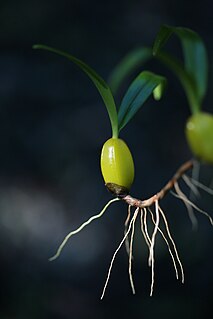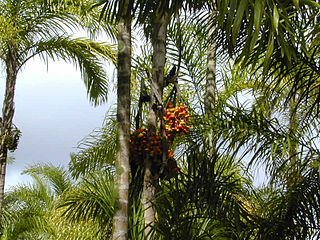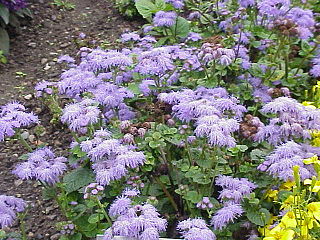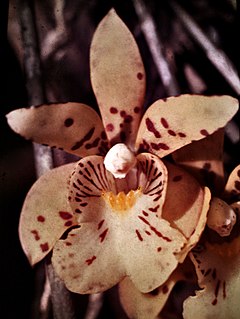| Maxillarieae | |
|---|---|
 | |
| Coconut orchid ( Maxillaria tenuifolia ) | |
| Scientific classification | |
| Kingdom: | Plantae |
| Clade: | Angiosperms |
| Clade: | Monocots |
| Order: | Asparagales |
| Family: | Orchidaceae |
| Subfamily: | Epidendroideae |
| Tribe: | Maxillarieae |
| Genera | |
70-80, See text | |
Maxillarieae is a large and complex tribe of orchids native to South and Central America. Within the tribe there are eight subtribes one of which is that of the genus Maxillaria .
In biology, a tribe is a taxonomic rank above genus, but below family and subfamily. It is sometimes subdivided into subtribes.

The Orchidaceae are a diverse and widespread family of flowering plants, with blooms that are often colourful and fragrant, commonly known as the orchid family.

South America is a continent in the Western Hemisphere, mostly in the Southern Hemisphere, with a relatively small portion in the Northern Hemisphere. It may also be considered a subcontinent of the Americas, which is how it is viewed in the Spanish and Portuguese-speaking regions of the Americas. The reference to South America instead of other regions has increased in the last decades due to changing geopolitical dynamics.
Tribe Maxillarieae contains 70 to 80 genera with about 1,000 species; most grow in tropical America as terrestrials or epiphytes, a few are myco-heterotrophs (formerly called saprophytes). Most show pseudobulbs, but a few have reedlike stems or thick underground stems. Blooms have four pollinia.

An epiphyte is an organism that grows on the surface of a plant and derives its moisture and nutrients from the air, rain, water or from debris accumulating around it. Epiphytes take part in nutrient cycles and add to both the diversity and biomass of the ecosystem in which they occur, like any other organism. They are an important source of food for many species. Typically, the older parts of a plant will have more epiphytes growing on them. Epiphytes differ from parasites in that they grow on other plants for physical support and do not necessarily affect the host negatively. An epiphytic organism that is not a plant is sometimes called an epibiont. Epiphytes are usually found in the temperate zone or in the tropics. Epiphyte species make good houseplants due to their minimal water and soil requirements. Epiphytes provide a rich and diverse habitat for other organisms including animals, fungi, bacteria, and myxomycetes.

The pseudobulb is a storage organ found in many epiphytic and terrestrial sympodial orchids. It is derived from a thickening of the part of a stem between leaf nodes and may be composed of just one internode or several, termed heteroblastic and homoblastic respectively. All leaves and inflorescences usually arise from this structure. Pseudobulbs formed from a single internode produce the leaves and inflorescence from the top, while those that are formed from several internodes can possess leaves along its length. The modified sheath leaves that appear at the base of a pseudobulb and often enfold all or part of it are usually dry and papery, though in some orchids the sheaths bear leaf blades and the leaves at the pseudobulb's apex are reduced to scales.

A pollinium is a coherent mass of pollen grains in a plant that are the product of only one anther, but are transferred, during pollination, as a single unit. This is regularly seen in plants such as orchids and many species of milkweeds (Asclepiadoideae). Usage of the term differs: in some orchids two masses of pollen are well attached to one another, but in other orchids there are two halves each of which is sometimes referred to as a pollinium.
- Subtribe Corallorhizinae: all epiparasites.
- Genera: Aplectrum , Corallorrhiza
- Subtribe Zygopetalinae: about 150 species. Most exhibited hybrids are to be found in this subtribe.
- Alliance Warrea
- Alliance Zygopetalum
- Genera: Acacallis , Aganisia , Batemannia , Bollea , Cheiradenia , Chondrorhyncha , Cochleanthes , Colax , Pabstia , Promenaea , Zygopetalum
Batemannia is a genus of flowering plants from the orchid family, Orchidaceae. It contains 5 species, native to Trinidad and South America:

Pescatoria is a genus of flowering plants from the orchid family, Orchidaceae. It is native to Costa Rica, Panama, and northern South America.
Cheiradenia is a genus of flowering plants from the orchid family, Orchidaceae. It contains only one known species, Cheiradenia cuspidata, native to northern South America.
- Alliance Bollea
- Genera: Bollea , Chondrorhyncha , Cochleanthes , Huntleya , Kefersteinia , Pescatoria , Stenia
Chondrorhyncha is a genus of flowering plants from the orchid family, Orchidaceae. At the present time 7 species are recognized, though many more names have been proposed. All species are native to Colombia, Venezuela and Ecuador.
- Chondrorhyncha hirtziiDodson - Ecuador
- Chondrorhyncha ineditaDressler & Dalström - Colombia
- Chondrorhyncha macronyxKraenzl. - Colombia
- Chondrorhyncha panguensisDodson ex P.A.Harding - Ecuador
- Chondrorhyncha roseaLindl. - Colombia, Venezuela
- Chondrorhyncha suareziiDodson - Ecuador
- Chondrorhyncha velastiguiiDodson - Ecuador
The genus Cochleanthes is made up of 4 species of orchids native to Mexico, Central America, the West Indies and South America. The name Cochleanthes refers to the shape of the flower.

Huntleya is a small orchid genus native to South America, Central America and Trinidad.
- Alliance Vargasiella
- Genera: Vargasiella
- Unallied Genera within Zygopetalinae
- Genera: Benzingia , Chaubardia , Chaubardiella , Dodsonia , Galeottia , Hoehneella , Koellensteinia , Neogardneria , Paradisanthus , Scuticaria , Warreella , Warreopsis , Zygosepalum
- Alliance Hybrids (Nothogenerics)
- Genera: Aitkenara , Bateostylis , Bollopetalum , Chondrobollea , Cochella , Cochlecaste , Cochlenia , Downsara , Durutyara , Hamelwellsara , Huntleanthes , Kanzerara , Keferanthes , Lancebirkara , Otocolax , Otonisia , Palmerara , Rotorara , Zygocaste , Zygolum , Zygonisia , Zygostylis
Otostylis is a genus of flowering plants from the orchid family, Orchidaceae, native to South America and Trinidad.
- Otostylis alba(Ridl.) Summerh. - Venezuela, Brazil, Guyana
- Otostylis brachystalix(Rchb.f.) Schltr. - Venezuela, Brazil, Guyana, Trinidad, Colombia, Peru
- Otostylis lepida(Linden & Rchb.f.) Schltr. - Venezuela, Brazil, Guyana, Suriname
- Otostylis paludosa(Cogn.) Schltr. - Peru, Mato Grosso
Warrea is a genus of flowering plants from the orchid family, Orchidaceae. It has three known species, all native to Latin America.

Aganisia is a small South American genus in the orchid family (Orchidaceae), subfamily Epidendroideae.
- Subtribe Bifrenariinae: thin and pleated leaves.
- Genera: Bifrenaria , Xylobium
- Subtribe Lycastinae: thin and pleated leaves.
- Genera: Anguloa , Bifrenaria , Lycaste , Neomoorea , Rudolfiella , Sudamerlycaste Teuscheria , Xylobium
- Subtribe Stanhopeinae:
- Genera: Acineta , Archivea , Braemia , Cirrhaea , Coryanthes , Embreea , Gongora , Horichia , Houlletia , Jennyella , Kegeliella , Lacaena , Lueddemannia , Paphinia , Polycycnis , Schlimmia , Sievekingia , Soterosanthus , Stanhopea , Trevoria , Vasqueziella
- Subtribe Coeliopsidinae:
- Genera: Coeliopsis , Lycomormium , Peristeria
- Subtribe Maxillariinae: largest subtribe with nearly half of the tribe species. The leathery leaves are conduplicate, i.e. folded together lengthwise.
- Genera: Chrysocycnis , Cyrtidium , Maxillaria , Mormolyca , Pityphyllum , Scuticaria (plant) , Sepalosaccus , Trigonidium
- Subtribe Dichaeinae
- Genera: Dichaea
- Subtribe Telipogoninae
- Genera: Telipogon , Trichoceros
- Subtribe Ornithocephalinae
- Genera: Ornithocephalus , Zygostates

Aplectrum hyemale is a species of orchid native to the eastern United States and Canada, from Oklahoma east to the Carolinas and north to Minnesota, Ontario, Quebec and Massachusetts. It is particularly common in the Appalachian Mountains, the Great Lakes Region, and the Ohio and Upper Mississippi Valleys. Isolated populations are also reported from Arizona.

Zygopetalinae is an orchid subtribe in the tribe Cymbidieae with 418 species.

In biology, a hybrid is the offspring resulting from combining the qualities of two organisms of different breeds, varieties, species or genera through sexual reproduction. Hybrids are not always intermediates between their parents, but can show hybrid vigour, sometimes growing larger or taller than either parent. The concept of a hybrid is interpreted differently in animal and plant breeding, where there is interest in the individual parentage. In genetics, attention is focused on the numbers of chromosomes. In taxonomy, a key question is how closely related the parent species are.














